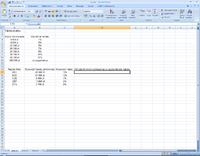Hello, I have a few doubts about Excel. I am not asking for a ready-made solution, but for a hint and explanation of what, where, and what.
In the first order, I have to adjust the amount of the discount to the amount of the order. So, for example, from PLN 4,000 the discount is 1%, from 8,000 - 2% and so on. I don't know what pattern to use.
In the second command, I am supposed to calculate the discount amount based on the order amount using only the if function.
Besides, I don't know what it means:
It should be remembered that the sheet generated in tasks 1, 2 and 4 is to react appropriately to any entered values. You should not use hard assignments, only conditional functions.
So if I create such a conditional function, the sheet will automatically calculate everything for me?
In the first order, I have to adjust the amount of the discount to the amount of the order. So, for example, from PLN 4,000 the discount is 1%, from 8,000 - 2% and so on. I don't know what pattern to use.
In the second command, I am supposed to calculate the discount amount based on the order amount using only the if function.
Besides, I don't know what it means:
It should be remembered that the sheet generated in tasks 1, 2 and 4 is to react appropriately to any entered values. You should not use hard assignments, only conditional functions.
So if I create such a conditional function, the sheet will automatically calculate everything for me?



